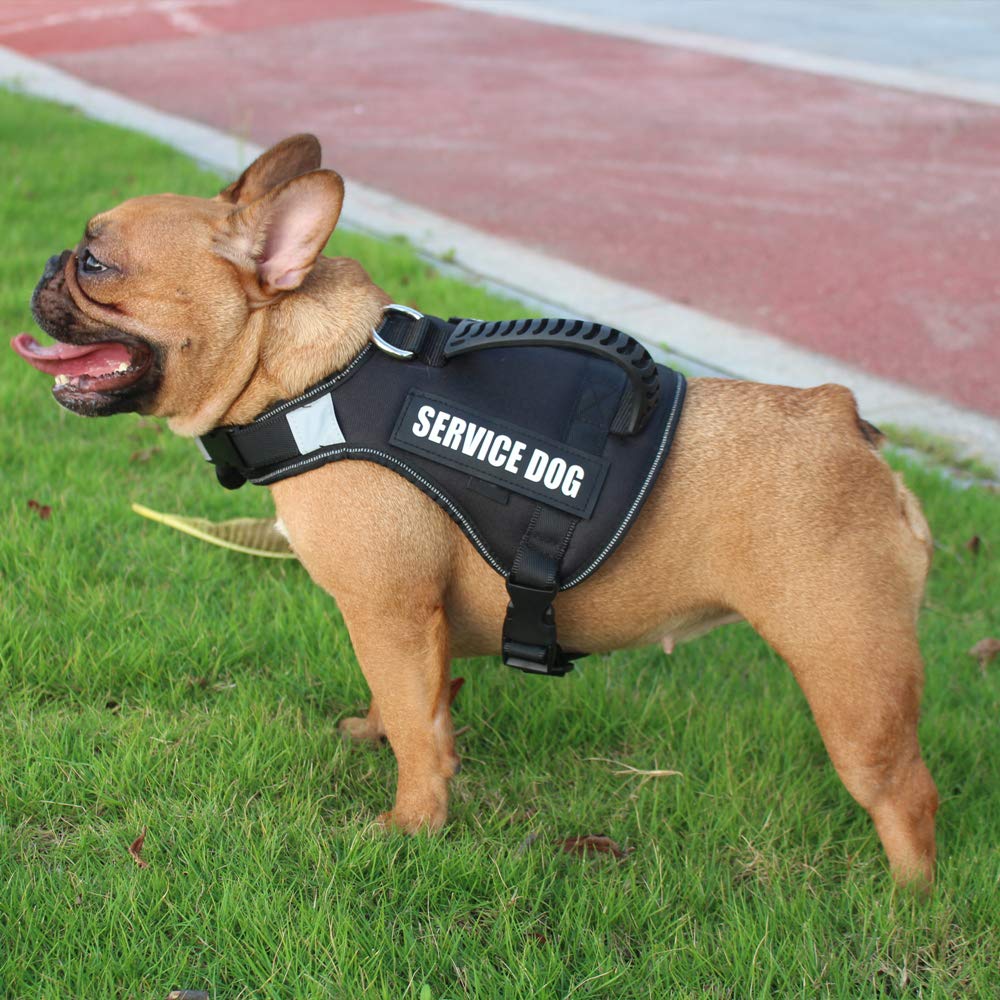Key Takeaways
Leash training your French Bulldog is essential for their development and safety.
Positive reinforcement is a powerful tool in leash training, rewarding desired behaviors.
Understanding your French Bulldog’s unique personality is key to effective training.
Leash training also serves as a foundation for training French Bulldogs as service dogs.
Training sessions should be consistent, short, and enjoyable for your Frenchie.
Benefits of Leash Training for Your Frenchie
Leash training your French Bulldog offers numerous benefits. It fosters a strong bond between you and your pet, enhances their social skills, and provides mental stimulation. Most importantly, it sets the stage for them to potentially become service dogs, where discipline and control are non-negotiable.
Explanation of the service dog training context

“No Pull Service Dog Vest Harness …” from www.amazon.com and used with no modifications.
When we talk about leash training in the context of service dogs, we’re looking at a specialized form of training. Service dogs must navigate various environments calmly and perform tasks that aid their handlers. For French Bulldogs to take on such a role, they must first master the basics of leash behavior to ensure they can handle advanced training without being distracted or overwhelmed.
Overview of the four quadrants of reinforcement and discouragement
Effective training hinges on understanding how dogs learn. There are four quadrants of reinforcement and discouragement that shape behavior: positive reinforcement, negative reinforcement, positive punishment, and negative punishment. By leveraging these methods thoughtfully, we can guide our French Bulldogs toward becoming well-behaved companions and, potentially, service dogs.
The Four Quadrants of Leash Training
Applying Positive Reinforcement
Positive reinforcement is about rewarding your Frenchie for good behavior. When they walk nicely on a leash without pulling, a treat or a cheerful “Good dog!” can work wonders. This encourages them to repeat the behavior because they associate it with positive outcomes.
Explanation, examples, and tips
For instance, if your French Bulldog maintains a steady pace beside you, immediately praise them and offer a treat. The key is timing—rewards must be given promptly to be effective. Here are some tips for positive reinforcement:
Keep a variety of treats handy to maintain interest.
Use a happy, enthusiastic tone to convey your approval.
Gradually increase the duration and difficulty of the desired behavior before rewarding.
Applying Negative Reinforcement
Negative reinforcement involves removing something unpleasant when the desired behavior is performed. For example, if the leash tightens due to pulling, and your dog returns to your side, releasing the tension is a form of negative reinforcement. They learn that walking close to you means no pressure on their neck. Discover more about French Bulldog training techniques for effective results.
Remember, the goal is not to cause discomfort but to teach your Frenchie that their actions can prevent it. Consistency is crucial—always relieve tension the moment your dog complies. For more detailed guidance, check out our behavior management training tips.
Negative reinforcement can be a bit tricky to understand, but it’s about creating a situation where the dog learns that their actions can remove something they find unpleasant. Let’s say your French Bulldog pulls on the leash, creating tension around their neck. When they finally ease off and come back to your side, you immediately release the tension on the leash. This relief teaches them that staying close to you is more comfortable than pulling away. For more detailed guidance, check out this step-by-step guide to leash training your French Bulldog.
However, it’s important to use negative reinforcement correctly to avoid any confusion or fear in your dog. The goal isn’t to punish them but to help them understand the right behavior.
Be consistent with your cues and the release of pressure.
Ensure the pressure is not painful but just enough to be an effective reminder.
Combine negative reinforcement with positive reinforcement for the best results.
By alternating between these reinforcements, your French Bulldog will start to understand what you expect from them on walks, setting a solid foundation for more advanced service dog training.
Applying Positive Punishment
Positive punishment might sound confusing, but it’s about adding something unpleasant to discourage a behavior. For example, if your Frenchie jumps on someone, you might say “No!” in a firm voice. The unpleasantness of your stern voice discourages the jumping.
Explanation, examples and tips
It’s essential to use positive punishment carefully, as it can sometimes lead to fear or aggression if not applied correctly. Here are some examples and tips:
A firm “No” or a quick leash tug can suffice to signal that a behavior is unwanted.
Always follow up with positive reinforcement when they correct their behavior.
Never use physical punishment—it’s not effective and can harm your relationship with your dog.
When used sparingly and alongside positive reinforcement, positive punishment can be a useful tool in your training arsenal.
Applying Negative Punishment
Negative punishment involves taking something away to decrease a behavior. If your Frenchie is playing with a toy and begins to nip, you might take the toy away. The removal of the toy right after the nipping behavior teaches them that nipping leads to less playtime.
Explanation, examples and tips
Here’s how you can apply negative punishment in leash training:
If your dog starts pulling on the leash, stop walking. The removal of forward movement shows them that pulling won’t get them where they want to go.
Once they calm down or return to your side, resume walking. This reinforces that calm behavior leads to positive outcomes.
Be patient and consistent. It might take several attempts before your dog makes the connection.
Negative punishment is a gentle way to discourage undesirable behaviors without causing fear or pain.
Understanding Your French Bulldog’s Unique Personality
Every French Bulldog is an individual with their own quirks and characteristics. Some may be headstrong, while others are more laid-back. Understanding these traits will help you tailor your training approach to suit your dog’s personality.
Good practices on leash training
Good practices in leash training include:
Starting training in a quiet environment to minimize distractions.
Using a consistent command or signal to indicate it’s time to walk nicely.
Keeping training sessions short and sweet to match your Frenchie’s attention span.
Remember, training should be fun for both of you. If either of you gets frustrated, take a break and try again later. For more detailed guidance, you can explore this comprehensive guide on French Bulldogs as service dogs.
Mistakes or myths on leash training
There are several common mistakes and myths surrounding leash training:
One myth is that some dogs just can’t be leash trained—this is not true. With patience and the right techniques, any dog can learn to walk nicely on a leash.
A common mistake is using too much force on the leash. This can cause neck injuries and make your dog fearful or aggressive.
Another mistake is not being consistent with commands and expectations, which can confuse your dog and slow down their learning.
By avoiding these pitfalls, you’ll be on the right track to having a well-behaved French Bulldog who’s ready for the responsibility of being a service dog.
Leash training your French Bulldog isn’t just about having a dog that walks nicely; it’s about creating a foundation for a disciplined and responsive canine companion. As you progress, you’ll find that the bond between you strengthens, and the possibilities of what you can achieve together grow. Whether you aspire for your Frenchie to become a service dog or simply a well-mannered pet, the journey starts at the end of the leash.
My favorite French Bulldog Training is from the K9 Training Institute.
Because they offer a professional service dog training approach to help French Bulldog owners train their dogs at home like professionals.
Join their Free Online Workshop on dog training.
Seeking help from a professional trainer
Here’s a list with different situations that you should consider seeking help from a professional trainer for leash training your French Bulldog:
- Struggling with leash manners
Despite consistent efforts using positive reinforcement techniques, if you’re still struggling with your Frenchie’s leash manners like pulling, lunging, or reactivity, a professional trainer can provide personalized guidance to address these specific issues. - Teaching advanced leash skills
If you want to teach advanced leash skills like loose leash walking, heel work, or off-leash reliability, trainers can break down these complex behaviors into manageable steps and use proven methods to reinforce them effectively. - First-time dog owner or new to the breed
French Bulldogs can be stubborn, and if you’re a first-time dog owner or new to the breed, a professional trainer can teach you the right techniques from the start, preventing the development of bad habits. - Dealing with behavioral issues
If you’re dealing with fear, aggression, or other behavioral issues that make leash training challenging or unsafe, trainers can assess the root cause and implement desensitization and counterconditioning protocols to modify the behavior. - Comprehensive, well-rounded training
If you want to ensure your Frenchie’s leash training is well-rounded and covers all essential aspects like loose leash walking, heel, recall, and proper leash pressure techniques, a trainer can provide a comprehensive curriculum tailored to your dog’s needs.
FAQs
At what age should I start leash training my French Bulldog?
The best time to start leash training is as soon as your French Bulldog puppy has settled into their new home. This can be as early as 8 weeks old. Puppies have short attention spans, so keep training sessions brief and fun. If you have an older dog, don’t worry—it’s never too late to start training! For more detailed steps, you can read about leash training your French Bulldog on our blog.
Early training establishes good habits and helps prevent the development of bad ones. It’s important to be gentle and patient, as young puppies are still growing and developing both physically and mentally.
Start with short, 5-minute sessions and gradually increase the duration as your puppy grows.
Use a light leash and collar to avoid putting too much pressure on your puppy’s neck.
Keep the mood positive and end each session on a good note with playtime or a treat.
How long should each leash training session be for a French Bulldog?
For adult French Bulldogs, aim for training sessions that are around 10 to 15 minutes long. This is enough time to practice new skills without overworking your dog. For puppies, shorter sessions of 5 minutes are best. You can have multiple sessions throughout the day to reinforce learning.
Remember, quality over quantity is key. It’s better to have a short session where your Frenchie is engaged and learning than a longer one where they become bored or distracted.
Can French Bulldogs be trained to walk off-leash?
Training a French Bulldog to walk off-leash is possible, but it requires a high level of recall training and trust. It’s important to start in a safe, enclosed area and gradually introduce more distractions as your dog proves reliable. Always prioritize safety and local leash laws.
Can you train a French Bulldog to be a service dog?
Yes, French Bulldogs can be trained as service dogs for certain types of work. While they may not be suitable for tasks requiring size or strength, like pulling a wheelchair, they can excel in roles that involve alerting to medical issues or providing emotional support.
Training a French Bulldog to be a service dog involves a significant commitment to training and socialization. It’s important to assess whether your individual dog’s temperament and abilities make them a good fit for service work.
Consider your dog’s health, as French Bulldogs can have respiratory issues that may limit their ability to perform certain tasks.
Assess your dog’s temperament—service dogs should be calm, adaptable, and responsive to training.
Seek the assistance of a professional trainer with experience in service dog training.
Why won’t my French Bulldog walk on a leash?
There could be several reasons why your French Bulldog is reluctant to walk on a leash. They might be scared or uncomfortable, especially if they’re not used to the leash or the environment. Pain or discomfort from an ill-fitting collar or harness could also be the culprit.
Address this by ensuring your dog’s gear fits properly and by gradually introducing them to the leash and walking in a familiar, safe environment. Positive reinforcement can help build their confidence. If the problem persists, consult a professional trainer or your veterinarian to rule out any medical issues.




